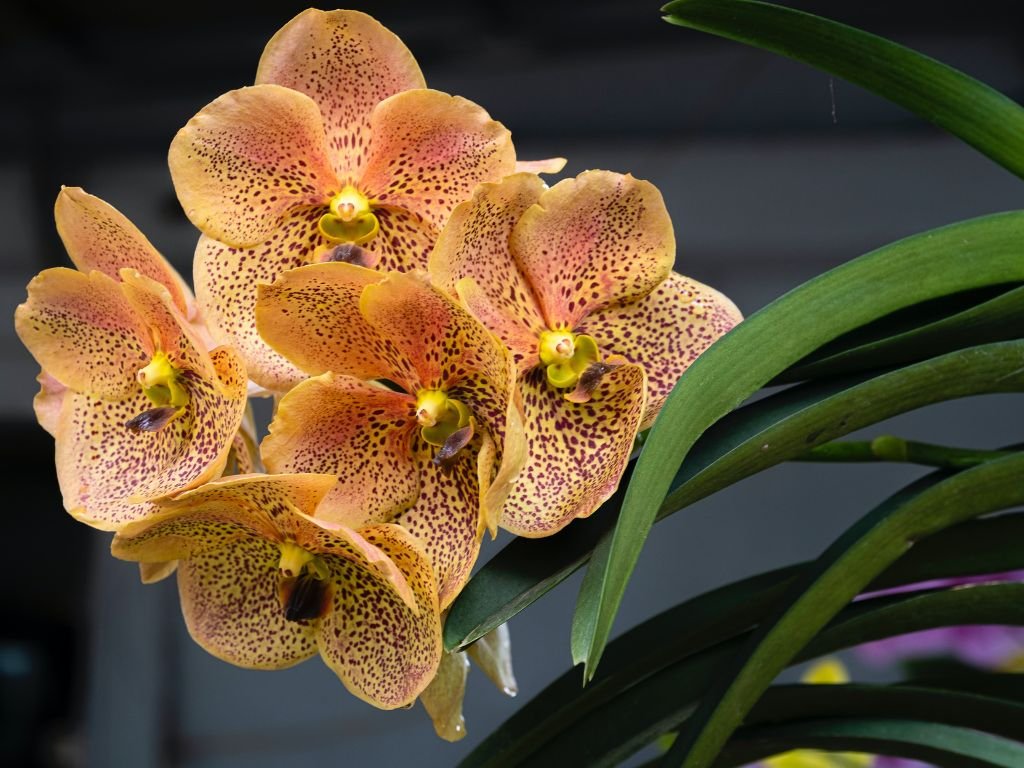Vanda orchids, a group of heat-loving orchid, are native to tropical Asia and are renowned for their colorful and fragrant blooms. While they are one of the few orchids that can produce blue flowers, they also come in a variety of other colors. These orchids are primarily epiphytic, meaning they attach their roots to nearby plants to absorb their specific requirements. They have large and robust roots that can be difficult to contain in a pot, and their unique water-absorbing roots enable them to cling to trees and other objects. The round foliage has a glossy waxy shine, and they come in various sizes, from miniatures to several feet tall.
These stunning and colorful orchids are useful as houseplants, but they do not tolerate cold temperatures. Vanda orchids grow upwards with one main stem and can adapt well to living wrapped around trees. Although some species can grow in soil, they require specific care and are best suited for experienced growers or greenhouse settings. With proper care, Vanda orchids can produce beautiful blooms several times a year, making them an excellent choice for a houseplant. When you establish the correct growing conditions, caring for these orchids becomes relatively simple, and they can bloom several times a year.
Temperature
Vanda orchids are fond of warm surroundings to grow healthily, although they can endure cold conditions for a brief period. During the daytime, Vanda orchids require temperatures ranging from 10°C to 35°C to flourish. For healthy growth, lower the temperature at night from 15°C to 25°C. While high temperature is crucial, it should be accompanied by adequate watering, nourishment, and humidity to ensure the plant’s optimal development.
Lighting
Vanda Orchids require ample amounts of bright sunlight, making east or southeast-facing windows ideal locations for indoor planting. If planting outdoors, partial shade is the preferred option to avoid scorching from excessive exposure to direct sunlight. Ensuring the appropriate amount of lighting is crucial to cultivating healthy and vibrant Vanda Orchids.
Watering
Watering for Vanda Orchids is heavily influenced by seasonal conditions. During the summer months, daily watering is necessary to maintain adequate moisture levels. In the winter season, watering should occur only once or twice per month. Consistently keeping the potting medium moist is important during the growing season, but overwatering should be avoided as it can lead to soil saturation and negatively impact the overall health of the plant. Striking the right balance with watering is essential to achieve optimal growth and longevity for Vanda Orchids.
Humidity
Vanda Orchids have a strong preference for an environment with high humidity levels. It is recommended to keep the humidity levels at around 70-80% while ensuring good air circulation. To achieve this, you can place a tray filled with water underneath your plant or use a humidifier to increase the humidity levels. This will create a comfortable and ideal atmosphere for your Vanda Orchids to thrive in.
Potting, Medium, and Repotting
Vanda orchids are epiphytic plants that can thrive in baskets or pots if properly potted and repotted. Good air circulation and quick drainage are essential for healthy growth. Pot Vanda orchids in a mixture of bark and moss. Repot them every two to three years, or sooner if they outgrow their current container. If you need more space, use a larger basket. You can leave the aerial roots hanging out of the basket. For best results, repot in the spring.
When repotting Vanda orchids, it is crucial to select a slightly larger container than the old one. You should prune the dead roots and place the plant in its new container. Soilless growing media can provide additional support for the roots. Potting and repotting Vanda orchids requires careful attention to detail and knowledge of the plant’s unique requirements.
Fertilization
Vanda orchids require proper fertilization to maintain the health of the plants and flourish. Use a well-balanced NPK fertilizer with a 20-20-20 ratio to ensure optimal growth and blooming.” This version puts the fertilizer first and makes it the grammatical subject of the sentence. Use a 20-20-20 NPK fertilizer to keep these magnificent flowers blooming at the right time. During the growing season, feed them with a balanced fertilizer once a week. In winter, fertilize once or twice a month to ensure they have enough nutrients to survive the cold weather. A high-phosphorus fertilizer can be particularly effective in promoting the growth and blooming of these stunning flowers. Remember to fertilize once a week during the growing season, and once or twice a month in the winter.
Pest & Diseases
Vanda orchids are susceptible to pests and diseases, notably mealybugs and spider mites. Applying rubbing alcohol or homemade pesticides effectively controls these pests without harming the plant. Fungal diseases, often caused by over-watering and improper lighting, afflict vandas. Common fungal diseases include root rot, black rot, leaf spots, and pseudobulb rot. To prevent fungal diseases, avoid over-watering to prevent waterlogging. Applying fungicide and trimming affected leaves and dead parts of the plant helps control fungal diseases. Prevent reoccurrence by ensuring proper watering in the future.
Vanda orchids need sufficient light to thrive and bloom. Non-blooming caused by insufficient lighting. Arrange fluorescent or LED lights near the plant to provide adequate lighting. The implant thing is to provide them with the right amount of water and light, and after noticing signs of pests or diseases, take prompt action.

